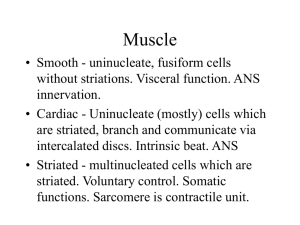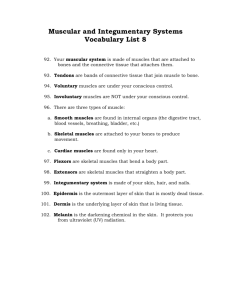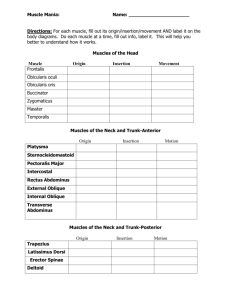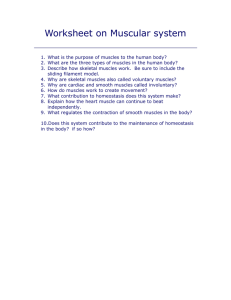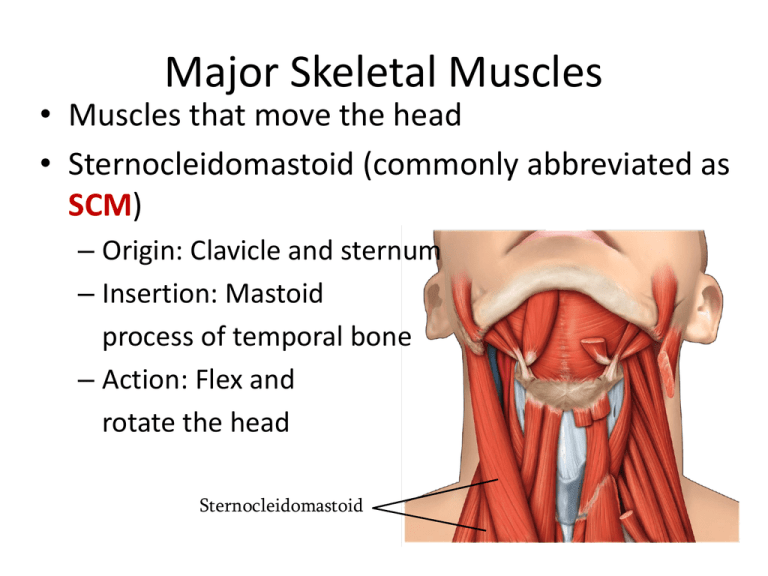
Major Skeletal Muscles
• Muscles that move the head
• Sternocleidomastoid (commonly abbreviated as
SCM)
– Origin: Clavicle and sternum
– Insertion: Mastoid
process of temporal bone
– Action: Flex and
rotate the head
Sternocleidomastoid
Major Skeletal Muscles
• Some of the more common muscles that originate on
the trunk include:
Pectoralis major and
minor
Anterior abdominal
muscle group
Latissimus dorsi
Biceps brachii
Diaphragm
Trapezius
Deltoid
Major Skeletal Muscles
• Muscles that move the pectoral girdle (shoulder)
• Pectoralis major
– Origin: Clavicle and
sternum
– Insertion: Proximal
humerus
– Action: Adducts and
medially rotates the
arm at the shoulder joint
• Pectoralis minor
– Origin: Ribs 3–5
– Insertion: Coracoid
process of the scapula
– Action: Internally
rotates the shoulder
Major Skeletal Muscles
• Muscles that move the pectoral girdle (shoulder)
• Deltoid Muscle
– Origin: Lateral clavicle and upper scapula
– Insertion: Deltoid tuberosity
on the shaft of the humerus
Deltoid
– Action: Abducts, flexes, and
medially rotates the upper arm
at the shoulder joint
Major Skeletal Muscles
• Muscles that move the pectoral girdle
(shoulder)
• Trapezius
– Origin: Occipital bone and
Trapezius
cervical spine
– Insertion: Clavicle, scapula and
lower thoracic vertebrae
– Action: Supports the arm and
moves the scapula up, down,
in, and out
Major Skeletal Muscles
• Muscles that move the pectoral girdle
(shoulder)
• Latissimus dorsi
– Origin: Thoracic and lumbar
vertebrae and the iliac bone
– Insertion: Mid-humerus
– Action: Drives arm inferiorly
and posteriorly (the
Latissimus
dorsi
swimmer’s muscle)
Major Skeletal Muscles
• Anterior abdominal wall
• Rectus abdominis
– Origin: Pubic bone
– Insertion: Ribs and sternum
• External oblique
– Origin: Ribs 5–12
– Insertion: Iliac crest and
linea alba
– Actions: Flexes vertebral column
and compresses abdomen
Major Skeletal Muscles
• The main muscle of inspiration is the diaphragm.
– Origin: Inferior 6 ribs
(anteriorly) and lumbar
vertebrae (posteriorly)
– Insertion: Central
tendon
Diaphragm
Central
tendon
Major Skeletal Muscles
• Some of the more common muscles of the
extremities include:
Triceps brachii
Brachioradialis
Thenar muscles
Quadriceps group: Rectus femoris, along with the
vastus lateralis, vastus intermedius, and vastus
medialis
Hypothenar muscles
Tibialis anterior
Gluteus maximus
Gastrocnemius
Biceps femoris
Soleus
Major Skeletal Muscles
• Muscles that move the Radius and Ulna
• Biceps brachii
– Origin: Scapula
– Insertion: Radius
– Action: Flexes and
supinates forearm at
elbow joint and flexes
arm at shoulder joint
• Brachialis
– Origin: Distal anterior
surface
of humerus
– Insertion: Ulna
– Action: Flexor of forearm
at elbow
Major Skeletal Muscles
• Muscles that move the Radius and Ulna
• Triceps brachii
Origin: Scapula and posterior surface of humerus
Insertion: Olecranon
process of ulna
Action: Extends
forearm at elbow
joint and arm
at shoulder joint
Major Skeletal Muscles
• Muscles that move the Radius and Ulna
• Brachioradialis
– Origin: Humerus
– Insertion: Distal radius
– Action: Supinates the forearm
at the radioulnar joint
Major Skeletal Muscles
• Muscles that move the wrist, hand, thumb,
and finger
• Thenar: lateral aspect of palm
• Hypothenar: medial aspect of palm
– Action: Oppose thumb
against other 4 fingers
Thenar
Hypothenar
Major Skeletal Muscles
• Muscles that move the
femur
• Gluteus maximus
Origin: Iliac crest, sacrum,
and coccyx
Insertion: Femur
Action: Extends and laterally
rotates thigh at hip joint
Gluteus
maximus
Major Skeletal Muscles
• Muscles that move the femur, tibia,
and fibula
• Quadricep group (Rectus femoris,
vastus lateralis, vastus intermedius,
and vastus medialis)
– Origin: Iliac spine and proximal femur
– Insertion: Patella and proximal tibia
– Action: Flexes thigh at high joint and
extends leg at knee joint
Major Skeletal Muscles
• Muscles that move the
femur, tibia, and fibula
• Hamstring group: (Biceps
femoris,
Semitendinosus, and
Semimembranosus)
– Origin: Ischial tuberosity
– Insertion: Proximal tibia
and fibula
Major Skeletal Muscles
• Muscles that move the femur, tibia,
and fibula
• Tibialis anterior
– Origin: Tibia
– Insertion: First cuneiform
and first metatarsal
– Action: Dorsiflexes and
inverts the foot
Major
Skeletal
Muscles
Muscles that plantar flex the foot at the ankle joint (standing on
“tip toes”)
• Gastrocnemius and soleus muscles
function as one – often called the
gastrocsoleus muscle
– Origin: Femur, capsule of
knee, and head of fibula
– Insertion: Calcaneus by way
of calcaneal (Achilles) tendon
Major Skeletal Muscles
Major Skeletal Muscles
Imbalances of Homeostasis
• Exercise-induced muscle damage
After intense exercise, electron micrographs reveal
considerable muscle damage including torn
sarcolemmas and disrupted Z-discs.
Blood levels of proteins normally confined only to
muscle (including myoglobin and the enzyme,
creatine kinase) increase as they are released from
damaged muscle.
Imbalances of Homeostasis
• Spasm
A sudden involuntary contraction of a single muscle
within a large group of muscles – usually painless
• Cramp
Involuntary and often painful muscle contractions
Caused by inadequate blood flow to muscles (such as
in dehydration), overuse and injury, and abnormal
blood electrolyte levels
Imbalances of Homeostasis
• Disease States and Disorders
Fibrosis (myofibrosis)
• Replacement of muscle fibers by excessive amounts of
connective tissues (fibrous scar tissue)
Myosclerosis
• Hardening of the muscle caused by calcification
Both myosclerosis and muscle fibrosis occur as a
result of trauma and various metabolic disorders.
Imbalances of Homeostasis
• Aging
In part due to decreased levels of physical activity,
with aging, humans undergo a slow, progressive loss
of skeletal muscle mass that is replaced largely by
fibrous connective tissue and adipose tissue.
Muscle strength at 85 is about half that at age 25.
Compared to the other two fiber types, the relative
number of slow oxidative fibers appears to increase.
End of Chapter 11
Copyright 2012 John Wiley & Sons, Inc. All rights reserved.
Reproduction or translation of this work beyond that permitted in
section 117 of the 1976 United States Copyright Act without
express permission of the copyright owner is unlawful. Request for
further information should be addressed to the Permission
Department, John Wiley & Sons, Inc. The purchaser may make
back-up copies for his/her own use only and not for distribution or
resale. The Publisher assumes no responsibility for errors,
omissions, or damages caused by the use of these programs or
from the use of the information herein.






